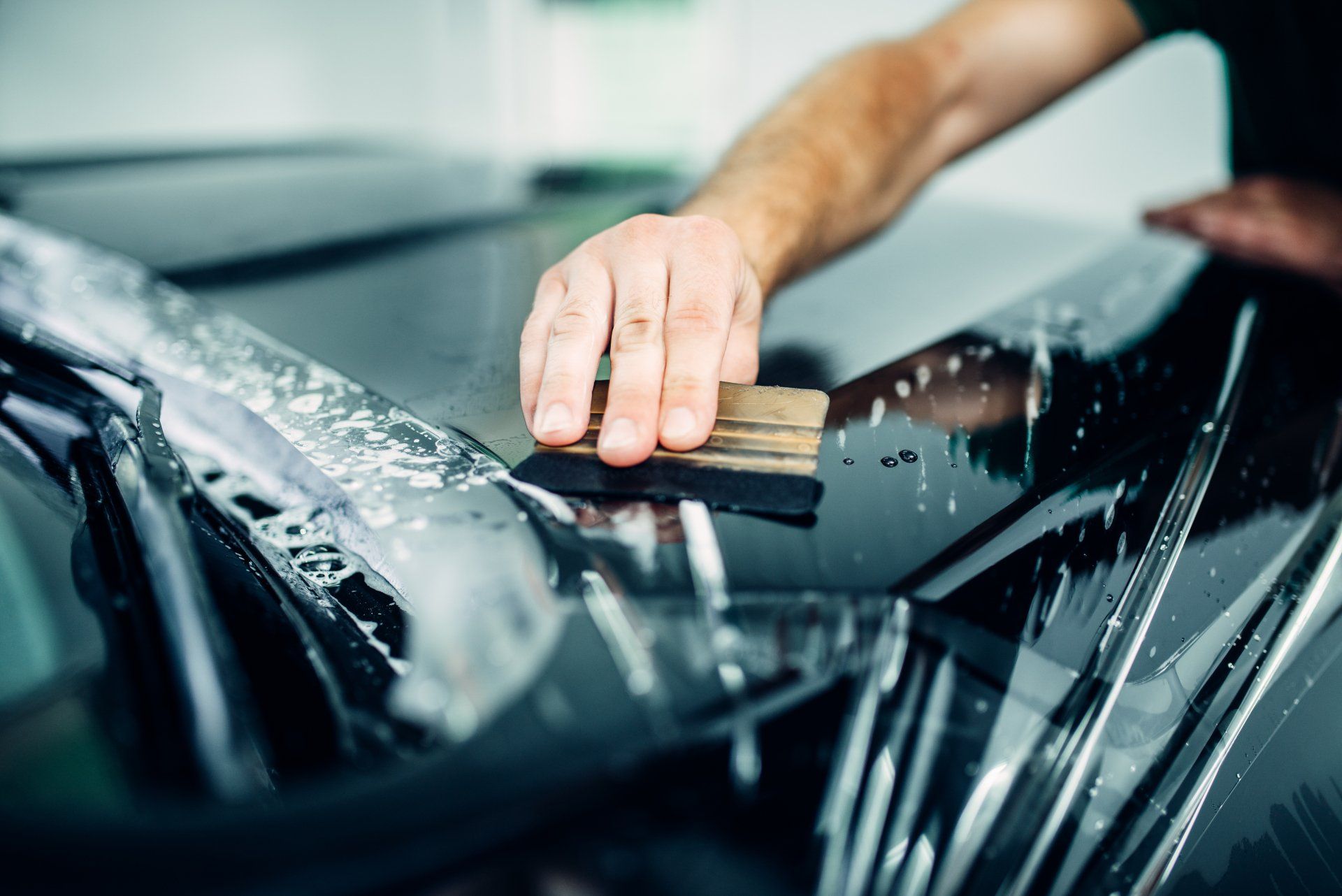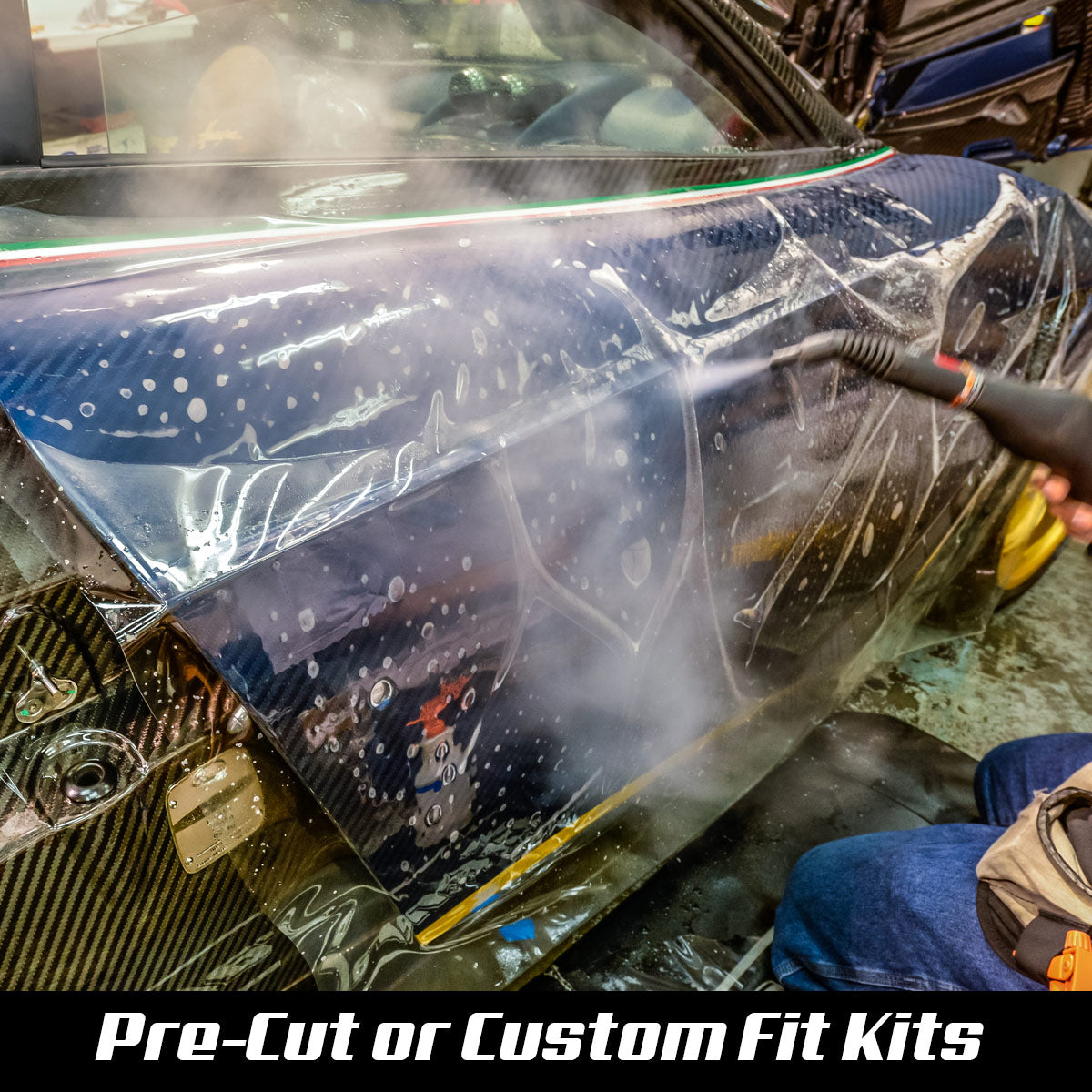The Ultimate Overview to Comprehending Paint Protection Film for Vehicle Fanatics
Paint Protection Film (PPF) has come to be a necessary topic amongst automobile lovers looking for to maintain their lorry's appearance. This innovative protective layer uses numerous advantages, from securing against ecological hazards to maintaining resale value. Comprehending the various sorts of PPF, the application procedure, and upkeep suggestions can greatly affect one's financial investment. Yet, numerous misunderstandings persist. What are the most usual myths, and how do they compare to various other protective alternatives?
What Is Paint Protection Film (PPF)?
Paint Protection Film (PPF) acts as a transparent shield for automobile surface areas. This advanced polyurethane material is made to stick effortlessly to a car's exterior, giving a protective layer versus different environmental threats. PPF is commonly used to high-impact locations, such as hoods, bumpers, and mirrors, where scrapes and chips are most likely to occur.The movie is incredibly long lasting, using resistance versus UV rays, road debris, and chemical spots, which can break down an automobile's coating with time. Its self-healing residential properties permit small scrapes to go away with warmth direct exposure, keeping a spotless look. PPF is offered in different surfaces, including gloss and matte, to match various paint designs and preferences.Installation needs precision, commonly best done by specialists to guarantee a perfect application. On The Whole, Paint Protection Film is a cutting-edge solution for vehicle lovers looking for to protect their car's visual appeal while securing its surface area integrity.
Advantages of Utilizing Paint Protection Film
While numerous auto fanatics focus on looks, the sensible benefits of Paint Protection Film (PPF) are just as engaging. PPF works as a durable barrier against various ecological risks, including road particles, rock chips, and insect discolorations, successfully protecting the car's exterior. Furthermore, it offers UV security, preventing paint from fading and keeping the automobile's vivid color over time.Another considerable advantage is the self-healing properties of sophisticated PPFs, which can recoup from minor scratches and swirl marks with warmth exposure, making sure the finish stays beautiful. Installment of PPF can also enhance resale worth; possible purchasers are usually attracted to properly maintained cars without any noticeable imperfections. PPF is simple to tidy and needs marginal upkeep, enabling car fanatics to appreciate their cars without the tension of constant maintenance. In general, PPF integrates performance with appearances, making it a practical financial investment for vehicle enthusiasts.
Different Types of Paint Protection Film
Understanding the various kinds of paint defense movie is crucial for auto fanatics. Secret functions such as self-healing innovation, contrasts of thickness and sturdiness, and application methods play an important function in selecting the right choice. Each type offers distinct benefits that deal with various needs and choices.
Self-Healing Modern Technology Explained
Self-healing innovation revolutionizes the way automobile enthusiasts safeguard their automobiles from square one and minor damage. This ingenious attribute is mainly found in innovative paint security films (PPF) When exposed to warmth from sunshine or a cozy atmosphere, the distinct polymers within these films soften, allowing small scratches and swirl marks to "heal" themselves. This self-repairing ability not only maintains the movie's visual charm but additionally extends its safety high qualities. Different brands use various solutions of self-healing movies, each with distinct qualities tailored to details demands. Auto lovers value this innovation for its capacity to keep their lorries looking beautiful, lowering the frequency of repair services and guaranteeing a longer-lasting safety solution against day-to-day wear and tear.

Density and Resilience Contrast
Thickness and sturdiness are crucial variables when examining various types of paint protection film (PPF) PPF typically ranges in density from 6 mils to 12 mils, with thicker films offering boosted resistance to scratches, chips, and ecological damage. Thinner films, while much less protective, usually supply much better clarity and conformability, making them appropriate for elaborate designs and contours. Longevity differs amongst brand names and types; some films incorporate innovative materials that boost their lifespan and preserve their appearance with time. In addition, self-healing buildings in certain PPF types can further extend longevity by allowing minor scratches to disappear with heat. Ultimately, the choice of thickness and resilience ought to line up with the certain demands and choices of the car enthusiast.
Application Methods Introduction
Picking the right application technique is important for making the most of the benefits of paint security movie (PPF) There are various techniques offered, each matched to various choices and ability degrees. One of the most useful source usual strategies include the typical wet application, which utilizes a slip service to assist in positioning, and the dry application, which needs precision and experience for instant bond. Additionally, advanced options like pre-cut packages offer ease, made to fit certain lorry models, while bulk movie enables modification yet requires extra competence (SpeedEFX Paint Protection Film). Each method provides special benefits and difficulties, making it essential for automobile fanatics to select one that aligns with their objectives and capabilities, ultimately making sure ideal defense for their cars
The Application Refine of PPF
The application process of paint defense film (PPF) entails several essential steps to assure perfect outcomes. First, detailed surface prep work is important, adhered to by particular installment methods that make best use of adhesion and protection. Correct post-application care is necessary to keep the film's honesty and look over time.
Surface Preparation Steps
Correct surface area prep work is vital for an effective paint defense film (PPF) application, as it straight influences the movie's attachment and longevity. The initial step involves thoroughly washing the vehicle to remove dirt, grime, and other contaminants. A pH-neutral automobile soap is suggested to prevent damaging the paint. Complying with the laundry, the surface ought to be dried carefully with microfiber towels to avoid water areas. Next off, any type of existing flaws, such as scratches or swirls, should be attended to, normally making use of a gloss or substance. The surface area needs to be cleaned down with an isopropyl alcohol remedy to assure it is completely clean and free from oils or residues. This meticulous preparation lays the foundation for a successful PPF installation.
Installment Strategies Explained
Understanding the application process of paint protection film (PPF) is important for achieving the most effective outcomes. The installment commonly starts with specific dimensions of the automobile's surface areas to ensure appropriate protection. Tidiness is vital; the surface area should be devoid of dust, dust, and pollutants. An installer typically utilizes a slip solution, which promotes positioning the movie during application.The movie is thoroughly laid onto the surface area, utilizing devices like squeegees to get rid of air bubbles and excess service. Warmth may be put on conform the film to intricate curves and shapes. Proper positioning and tension are necessary for a seamless surface. Cutting excess film assures a tidy edge, finishing the installment process effectively and boosting the vehicle's looks and protection.
Post-Application Treatment Tips

Upkeep Tips for Long-Lasting Protection
Just how can auto enthusiasts assure their paint defense movie remains reliable with time? Routine upkeep is necessary to secure the film's longevity and performance (SpeedEFX Paint Protection Film). To start with, washing the vehicle with a pH-balanced auto hair shampoo assists avoid the buildup of impurities that can harm the film. Using a microfiber cloth for drying is advised to prevent scratches.Additionally, it is crucial to prevent rough cleansing devices or severe chemicals, which can degrade the film's surface. Using a sealant or wax especially developed for paint protection film can give an additional layer of protection against UV rays and ecological elements.Furthermore, enthusiasts must routinely check the movie for any type of indicators of wear or damage, resolving problems without delay to maintain its protective top qualities. Vehicle parking in shaded locations or using cars and truck covers can also lessen direct exposure to damaging UV rays. By adhering to these maintenance ideas, vehicle lovers can assure their paint protection movie remains effective for years
Common Myths Concerning Paint Protection Film
What misunderstandings border paint protection film that vehicle fanatics should know? One widespread misconception is that paint protection movie (PPF) makes a vehicle appearance unattractive or yellow in time. In truth, premium PPF is made to remain clear and preserve its look. An additional usual idea is that PPF is only essential for new automobiles; nevertheless, any type of automobile can take advantage of this safety layer, no matter age. Some lovers you could try these out likewise believe that PPF is as well costly; while it may need an in advance investment, the long-term savings on paint repairs can offset initial prices. In addition, several think that PPF is a do it yourself job, but professional setup assurances appropriate alignment and attachment, optimizing efficiency. Finally, there is a misunderstanding that PPF is not durable, yet advancements in modern technology have actually made contemporary films immune to scratches, stains, and UV damages, supplying trustworthy security for years.
Contrasting PPF to Other Protection Options
Recognizing the different choices available for lorry security is very important for car fanatics who want to keep their car's appearance. Paint Protection Film (PPF) is usually compared to wax, ceramic coverings, and traditional sealants. While wax supplies a short-term shine and fundamental protection, it typically calls for regular reapplication and supplies restricted toughness. Ceramic finishings provide boosted defense versus UV rays and chemical stains, however they can be more costly and need specialist application.PPF stands apart because of its durable protection against physical damage, such as scrapes and rock chips. Unlike wax or sealers, PPF is a long-lasting service that can withstand rough conditions without deteriorating. Furthermore, PPF can self-heal from small abrasions, keeping its clarity and protective high qualities. On the whole, while each option has values, PPF is usually favored for its exceptional defense and durability, making it an optimal option for significant car enthusiasts.
Often Asked Concerns
The Length Of Time Does Paint Protection Film Last on a Car?
The durability of paint defense movie on a lorry commonly varies from 5 to 10 years, relying on factors such as environmental conditions, maintenance practices, and the quality of the film used during application.
Can PPF Be Removed Without Damaging the Vehicle's Paint?
The removal of paint security movie (PPF) can be executed meticulously, frequently without damaging the car's paint. SpeedEFX Paint Protection Film. The process requires correct methods and tools to assure the underlying surface area remains undamaged and intact.
Is PPF Installation a Do It Yourself Job or Best Entrusted To Professionals?
The concern of whether paint protection movie (PPF) setup appropriates for do it yourself lovers or best taken care of by experts frequently emerges. Lots of experts advise expert installment to assure suitable adherence More hints and avoid possible damage throughout the process.
Does Paint Protection Film Influence the Automobile's Resale Worth?
The effect of paint defense film on a vehicle's resale worth varies. While it can boost appearance and shield against damages, potential customers may have mixed sensations, valuing the film in a different way based on their preferences and experiences.
Can PPF Be Applied Over Existing Scrapes or Chips?
Applying paint protection movie (PPF) over existing scrapes or chips is typically not recommended. Blemishes might aggravate in time, and appropriate surface area prep work is vital for perfect bond and long life of the film's protective top qualities.